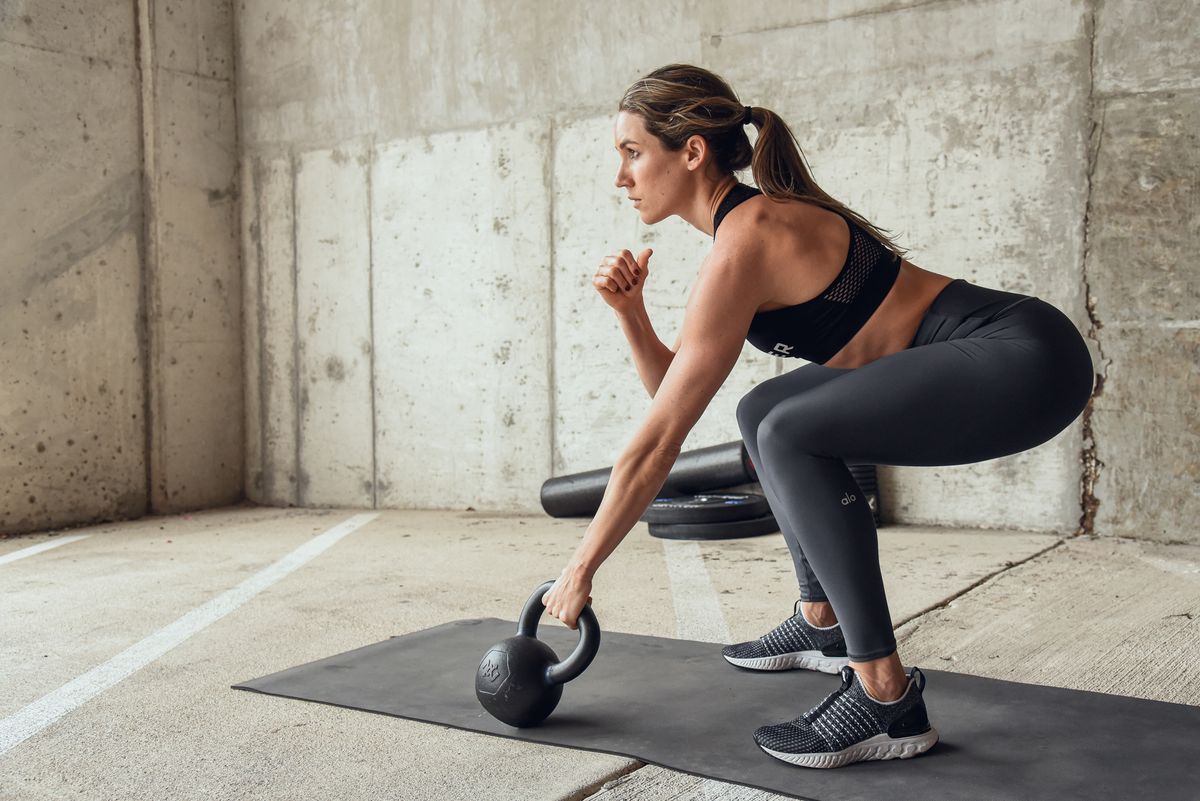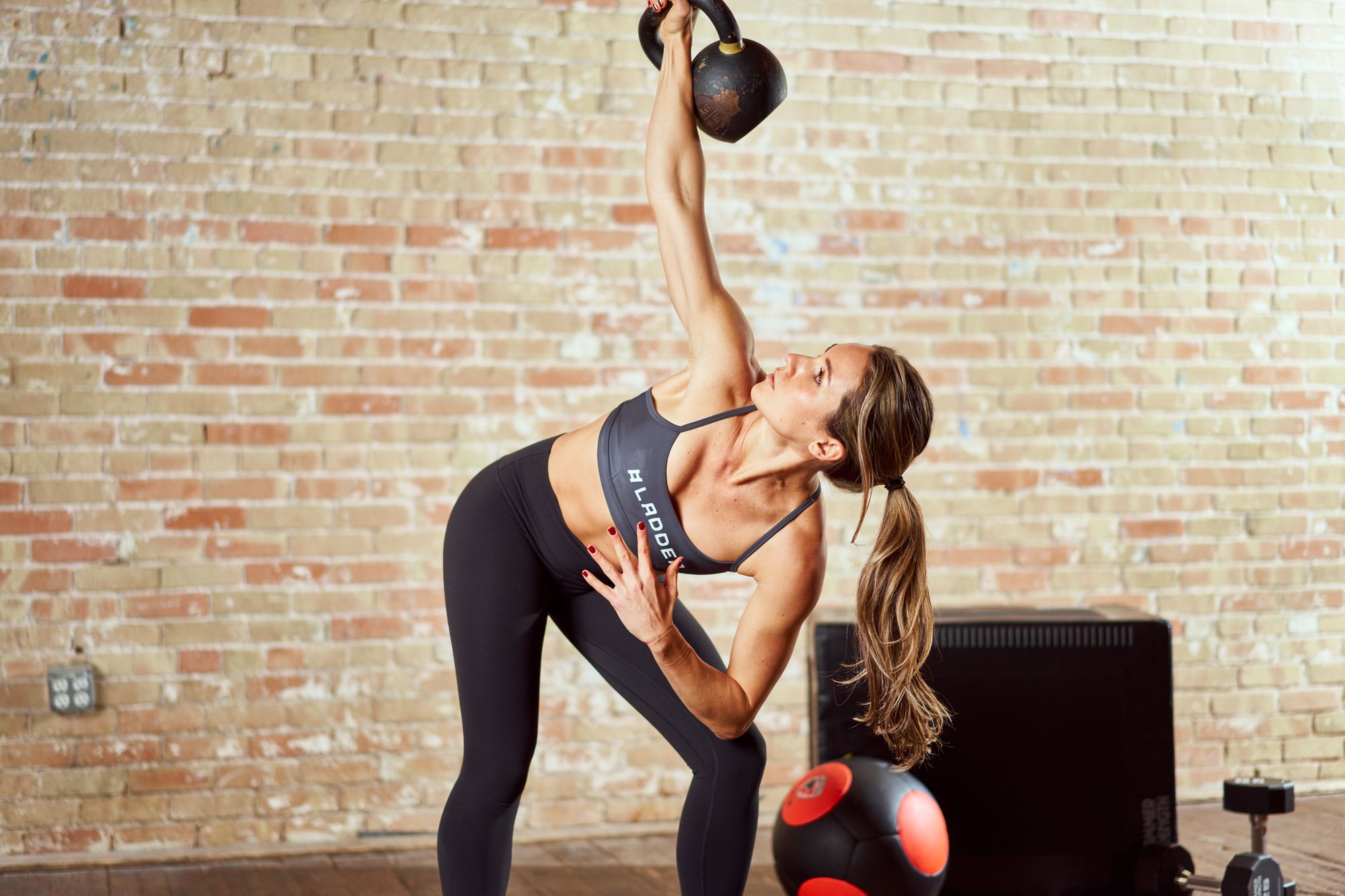How to Do a Kettlebell Windmill? (with video demonstration)

Master the Kettlebell Windmill Step-by-Step, and Avoid Common Mistakes and Injuries.

Lauren Kanski
Ladder Senior Coach, CPT

Kettlebell Windmill Introduction
Would you believe me if I said I can teach you one exercise that trains your rotational core, improves your stability, helps you balance, and increases your mobility?
It's true..and it's called the kettlebell windmill!
In this article and in my video demonstration, I’ll teach you how to properly perform the kettlebell windmill and how to incorporate the windmill into your workout routine and kettlebell training today.
I’ll also share the benefits of the windmill and help you avoid injury by showing you some of the common mistakes people make when learning this exercise.
Kettlebell Windmill Demonstration (audio & video)
Step-by-Step Instructions for the Kettlebell Windmill
Step 1:
Clean the kettlebell up into the racked position with your right hand and press it up overhead. Your knuckles should point to the ceiling, your elbow and wrist locked out…and no noodle arms!
Draw your shoulder down into its socket. Your feet should be shoulder’s width apart and heels on the same line.
Step 2:
Point both toes to the left at a 45 degree angle, while keeping heels in line with each other. Look up at the kettlebell, watching it the whole time.
Step 3:
On an inhale, begin to “sass” your right hip and glute back and up. Keep your right leg straight, knee soft and foot driving into the ground. This leg holds the majority of the weight in the windmill. The left knee is going to bend as much as needed as you start to rotate.
Step 4:
When your hips stop moving, your lower back starts to engage to go a little deeper into the movement. Left hand travels down the inside of your left thigh and knee. When your left elbow comes to about left knee height, that's as far as you need to go.
Step 5:
On an exhale, start to drive yourself back up the same way you came down. Keeping the bell in the same line, don't let it start to come forward or go back. Hips move back through.
Kettlebell Windmill Mistakes That Lead to Injury
Let's take a look at the most common mistakes people make when performing the kettlebell windmill and talk about how to avoid them so you can perform this exercise safely and effectively.
Mistake #1:
Not warming up correctly. Priming the shoulder and the hips is crucial before doing windmills. I recommend some arm bars, Turkish Get-ups, swings, etc
Mistake #2:
Not paying attention to your feet. If your feet are too far apart, it will cause excess strain on your lower back and shoulder. You want your feet to be about hip width apart with your toes pointed at a 45 degree angle. You want to keep your feet in line with your shoulders throughout the entire movement.
Mistake #3:
Not keeping your shoulders packed and arm completely locked out. When performing a kettlebell windmill, many people have a tendency to shrug their shoulders up towards their ears. This is a big no no! Also keeping your arm completely locked out through the wrist and elbow is crucial…no noodle arms!
Mistake #4:
Not Keeping the kettlebell in a fixed position. When performing the windmill, remember we are revolving around the kettlebell. It’s displacement stays the same. Don't let the bell fall back or come forward. This requires spatial awareness, shoulder stability and strength.
Mistake #5:
Not being mindful of where your non-working arm is during the movement. Your non-working arm should be kept straight down at all times, and should never cross over to touch your working hand or leg.
The Benefits of the Kettlebell Windmill
The kettlebell windmill is a “sneaky” exercise that focuses on breathing, core strength, and upper body stability, all while still being a hip dominant movement. Many people think it’s ONLY a shoulder stability and core exercise, and it absolutely is, but it’s also amazing for your glutes and hamstrings.
The windmill is a useful exercise for anyone who is interested in increasing proprioceptive awareness, rotational core strength, and shoulder stability as there are so many muscles that assist in the torso rotation. They are an often neglected source of strength, which is a shame because having strong obliques can translate into more stable posture and more explosive power from the core through to your extremities.
How to Incorporate the Kettlebell Windmill Into Your Workout Routine
Incorporating the kettlebell windmill is a great way to improve your abdominal muscles, hip mobility and oblique strength. The windmill exercise is also great for improving your core strength, scapular stability, balance and posture.
There are many variations of the windmill that you can use depending on what you want to accomplish in your workouts.
You can do a single arm windmill if you want to work on unilateral shoulder stability or you can do a double arm windmill when you want to add a little more load.
Take the time to learn how to do the kettlebell windmill correctly and keep in mind the following tips for incorporating the kettlebell windmill into your training routine:
- Learn how to perform the kettlebell windmill with proper form.
- Start by using an appropriately weighted kettlebell.
- Work up to heavier weight slowly. Keep it low volume (sets and reps).

Lauren Kanski
Ladder Senior Coach, CPT
Lauren is a Senior Coach at Ladder, a NASM-certified personal trainer, nutrition coach, Women’s Health Advisor, and published fitness writer based in New York City. Lauren’s online training program, BODY & BELL, available exclusively on the Ladder app, features daily full body workouts with a focus on kettlebell skills development and progressions.

